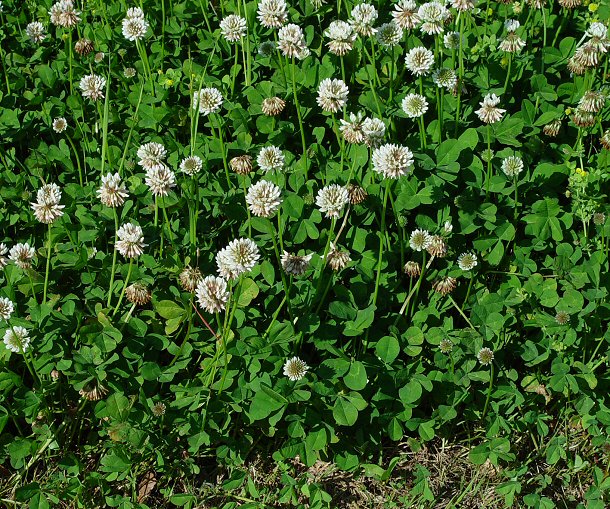Trifolium repens L.
White Clover

Introduced
CC = *
CW = 3
MOC = 66
© DETenaglia
Trifolium repens L.White Clover | |
 |
Introduced CC = * CW = 3 MOC = 66 |
© DETenaglia |
|
Family - Fabaceae/Faboideae Habit - Perennial forb with fibrous roots and sometimes short rhizomes. Stems - Prostrate, rooting at nodes, to 40 cm, glabrous or occasionally sparsely hairy. Leaves - Alternate, trifoliate, long-petiolate. Petioles to 20 cm, much longer than the leaflets, glabrous, with a shallow adaxial groove. Stipules ovate to lanceolate, fused most of the way into a sheathing tube (this rupturing as the inflorescence develops), the free portions short-tapered to the slender tips, membranous, whitish-to brownish-tinged, often with darker reddish to green veins, the margins entire. Leaflets 6-30 mm long, 10-25 mm wide, all sessile or nearly so, broadly elliptic to nearly orbicular, broadly angled at the base, bluntly pointed to more commonly rounded or shallowly to more deeply notched at the tip, the margins sharply and finely toothed, the surfaces glabrous or the undersurface sparsely hairy along the veins. Petiolules very short, pilose, to 1 mm.
Inflorescences - Dense globose umbels or very short racemes, 15-35 mm long and wide, the stalk (which are mostly erect and develop singly from the leaf axil) 50-200 cm long, glabrous or nearly so. Flowers 20-50 or more, the stalk 1-2 mm long at flowering, elongating to 4-6 mm and becoming sharply reflexed at fruiting. Pedicels erect in flower, recurved in fruit, each subtended by a small scarious bract.
Flowers - Calyces 3-5 mm long, the tube 1.8-3.0 mm long, glabrous, the teeth triangular-lanceolate, shorter than (upper teeth) to about as long as (lower teeth) the tube, unequal, often dark purple around the V-shaped sinuses, lacking a prominent network of nerves and not becoming inflated at fruiting. Corollas papilionaceous, 7-12 mm long, longer than the calyx lobes, white to pinkish-tinged, the banner outcurved, elliptic-obovate, mostly rounded at the tip, the margins sometimes minutely irregular, finely and usually inconspicuously nerved. Standard 8-9 mm long, 4 mm broad. Keels apically fused. Wings adnate to keels near the apex. Wings and keels fused to stamen tube. Stamens diadelphous, glabrous. Anthers yellow, 0.2-0.3 mm long. Ovary green, glabrous, 2.1 mm long in flower. Style glabrous, 3 mm long, upcurved, translucent. Stigma capitate.
Fruits - Legumes, enclosed by persistent corolla and calyx, 3-5 mm long, narrowly oblong in outline, 3-or 4-seeded. Seeds 0.9-1.5 mm long, nearly globose to slightly kidney-shaped, yellowish tan to brown, somewhat shiny. Flowering - May - November. Habitat - Forest edges, pastures, fields, lawns, roadsides, railroads, open disturbed areas. Origin - Native to Eurasia. Lookalikes - T. reflexum, T. hybridum, T. stoloniferum. Other info. - One of the most common "weeds" in Missouri, this plant can form large mats up to 2 m in diameter. It is found across Missouri and the continental U.S., though it is less common in a few Plains states. It is recognized by its white inflorescences (which can fade to pinkish) and prostrate, creeping habit with the nodes rooting. Though weedy, T. repens is an immensely important forage crop which was widespread in the continental U.S. by the mid 1700s. Photographs taken in the Ozark Scenic Riverways, Shannon County, MO., 6-16-05, and in Auburn, AL., 4-17-05 (DETenaglia); also near Labadie, Franklin County, MO, 5-10-2020 and 5-21-2021 (SRTurner). |